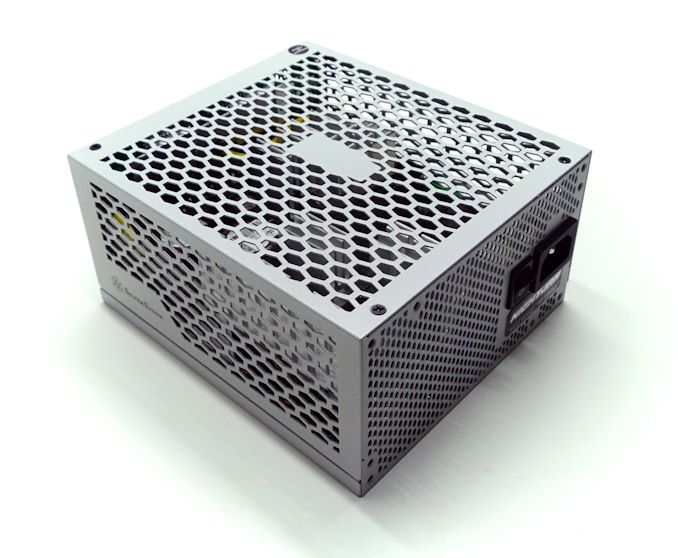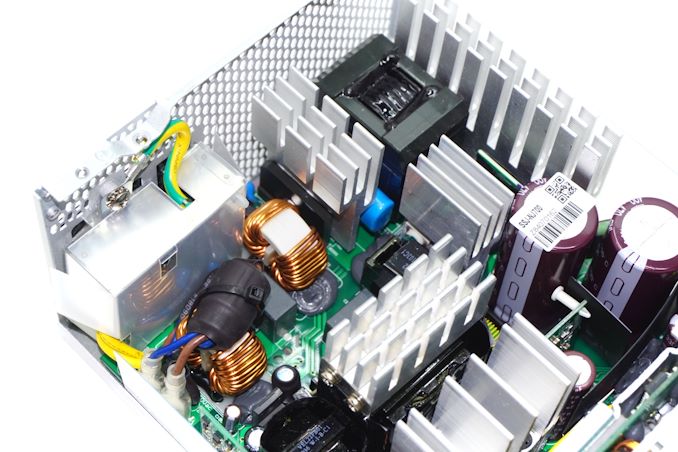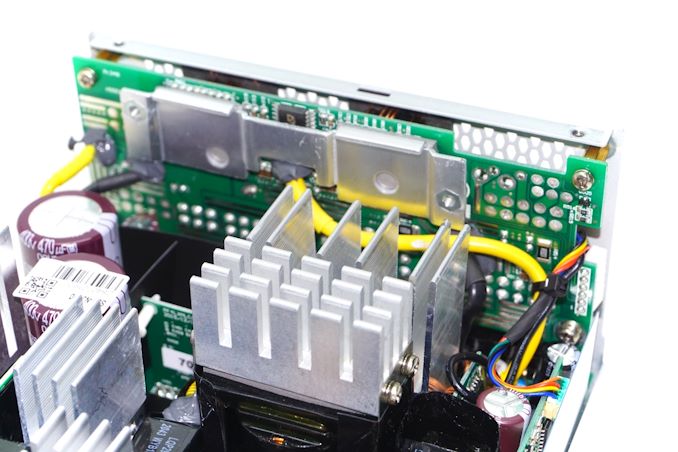The SilverStone NightJar NJ700 Passive PSU Review: Silent Excellence
by E. Fylladitakis on November 29, 2021 8:00 AM EST- Posted in
- Cases/Cooling/PSUs
- PSUs
- SilverStone
- Passive Cooling
Power Supply Quality
As part of our testing, we also check output parameters are within specifications, as well as voltage ripple and line noise.
| Main Output | ||||||||
| Load (Watts) | 141.38 W | 352.97 W | 528.19 W | 703.06 W | ||||
| Load (Percent) | 20.2% | 50.42% | 75.46% | 100.44% | ||||
| Amperes | Volts | Amperes | Volts | Amperes | Volts | Amperes | Volts | |
| 3.3 V | 1.8 | 3.41 | 4.49 | 3.41 | 6.74 | 3.4 | 8.99 | 3.39 |
| 5 V | 1.8 | 5.09 | 4.49 | 5.09 | 6.74 | 5.08 | 8.99 | 5.07 |
| 12 V | 10.42 | 12.1 | 26.06 | 12.08 | 39.09 | 12.05 | 52.12 | 12.03 |
| Line | Regulation (20% to 100% load) |
Voltage Ripple (mV) | |||||
| 20% Load | 50% Load | 75% Load | 100% Load | CL1 12V |
CL2 3.3V + 5V |
||
| 3.3V | 0.75% | 12 | 12 | 14 | 16 | 14 | 12 |
| 5V | 0.5% | 8 | 8 | 10 | 16 | 8 | 12 |
| 12V | 0.6% | 6 | 8 | 8 | 12 | 8 | 12 |
The power quality figures that we received while testing the SilverStone NJ700 inside our hotbox were astounding. We recorded a maximum voltage ripple of 12 mV on the 12V line at 100% load, an incredible power quality figure by any comparison. Voltage regulation also is very tight on the 12V line, staying lower than 0.6% across the nominal output range. The secondary 3.3V and 5V rails are a bit less well filtered, with the voltage ripple reaching 16 mV on both rails under maximum load. Otherwise, the secondary lines are just as tightly regulated, at around 0.5% for both the 3.3V and 5V rails.
Conclusion
SilverStone is greatly focused on the development of high-performance living room entertainment PCs, which goes in tandem with the marketing of ultra-quiet PSUs. The Nightjar NJ700 is a statement product designed both to lure in enthusiasts that will not mind the hefty price tag and to outdo the company’s main competitors.
The OEM behind the Nightjar NJ700 is SeaSonic, perhaps the most reputable top-tier PC PSU OEM. On top of that, the NJ700 is based on what is currently SeaSonic’s best platform. We found only top-tier components inside the Nightjar NJ700, ranging from critical parts down to insignificant filtering capacitors. The developer of this PSU spared no expense and that showed during our testing, when the Nightjar NJ700, a PSU that lacks any form of active cooling, was operating unaffected inside our hotbox and with virtually no change in its performance. SilverStone covers the Nightjar NJ700 with a five-year warranty, which is sufficient, yet strange when the OEM markets the same platform with a 12-year warranty.
Although the platform that the Nightjar NJ700 is analog and relatively basic by today’s standards, the designer of this PSU managed to get ridiculous performance figures out of it. The Nightjar NJ700 comes with an 80Plus Titanium certification tag and it honors it, delivering exceptionally high energy conversion efficiency even when the load is very low. Efficiency is not the only thing that the NJ700 excels on, as its power quality figures also are astounding. Despite its lack of active cooling, heat has practically no effect on the unit’s electrical performance either. All in all, the overall performance of the Nightjar NJ700 is world-class.
With all of that said, when using a passively cooled PSU, there are certain implications that need to be considered. The major point that is the fact that the thermal losses of the PSU will be released inside the system itself, whereas typical, active-cooled PSUs would exhaust most of that thermal energy to the outside of the case. This means that the system itself will get hotter and may require better cooling in order to sustain its overall performance. In this case, the high power output of the NJ700 translates to significant thermal losses when the unit is heavily loaded – regardless of its very high efficiency, there will be more than 35 Watts of thermal energy released to the environment. This will probably not be a problem with modern systems that are built with efficiency in mind, but the specifics of this must be considered and weighted by the system’s builder. After all, it would not make any sense to use a passively cooled PSU only to replace it by another noise source, such as additional case fans.
SilverStone’s choice to market the Nightjar NJ700 could not have been easy. On one hand, the nature of the product aligns with the company profile and their efforts to develop top-performance living room gaming systems. On the other hand, SilverStone has to compete with the OEM of the NJ700, the legendary SeaSonic, as they also market the same platform under their own brand. Practically no other company offers direct competition to the passively cooled NJ700 right now, meaning that its success largely depends on how well its $308 retail price and overall availability fare in comparison to SeaSonic’s Prime Fanless TX-700. That, in conjunction with the strangely significantly shorter warranty length, can be a very complicated subject for SilverStone’s marketing department.













46 Comments
View All Comments
IBM760XL - Monday, November 29, 2021 - link
As the owner of a SeaSonic Prime Ultra Titanium 650W (albeit with a fan), I'm not surprised by the performance covered in this review. It matches up with the reviews of SeaSonic's models I read prior to buying this PSU.The question does indeed seem to be why someone would buy this PSU in preference to SeaSonic's. The lesser warranty doesn't help that equation, and the SilverStone seems to be a little more expensive. Perhaps SilverStone has wider distribution channels and that's their plan? I'd be curious if there's any other reason to prefer the SilverStone.
Not that it really matters to me - my SeaSonic is under warranty until 2030, so I probably won't be in the PSU market for a few years.
shelbystripes - Monday, November 29, 2021 - link
This is like reading hybrid SUV reviews that confirms industry-leading fuel mileage, and commenting “as an owner of a pickup truck, why would someone buy one of these?”If you don’t need a silent PSU, you don’t need a silent PSU. There’s also the advantage of not having a fan built inside a PSU (which laypeople should NEVER open up, for safety reasons) as a potential point of failure. It’s easier and cheaper to manage the airflow in your HTPC, including replacing noisy or failing fans, if they aren’t built into your PSU…
dubyadubya - Monday, November 29, 2021 - link
Seasonic makes a completely fanless competitor, the SeaSonic Prime Fanless TX-700 so your analogy is a little off base IMO. In fact it is the same exact PSU for $26 less and it has a 12 year warranty instead of the 5 year warranty on the Silverstone. If I needed a fanless 700 watt PSU I know where my money is going to go. I tend to only buy PSU's made by Seasonic as IMO there are is nothing better so either way a great PSU.Oxford Guy - Sunday, December 5, 2021 - link
Silverstone is a middle man so it cut the warranty in order to find some place for margin.tonyou - Monday, December 6, 2021 - link
Actually Seasonic as an OEM does not offer warranty longer than 3 years no matter how much anyone is willing to pay. So its own retail division offering 12 year warranty is more or less a marketing cost, it doesn't mean the PSU will last any longer.jak0b-DK - Friday, December 10, 2021 - link
I don't have 12 years experience with seasonic yet, but the 5 years of using them in gaming-rigs and servers without any issues, make me suspect that they probably will endure.Also - knowing that a key factor to semiconductor (and Cap's) lifespan is heat - Less heat = longer life, it make sense that they can last longer in platinum series.
And finally - what company would offer 12 years of warrenty on a product expected to die within say 7 years. I trust that seasonic engineers know what they are doing, and apparently company exec's do so too. ;)
tonyou - Sunday, December 12, 2021 - link
All PSU manufacturers we work with including ourselves engineer power supplies to last the life of typical PCs. Other than design / production or bad batch from key components, most PSUs will be able to achieve that goal. With that said, even the best PSUs will not be 100% defect-free so that's what the warranty will hopefully cover. We are not saying that Seasonic or any other brands' PSU will not last up to 10 or 12 years. What we are trying to convey is that warranty length is not an indication of a PSU's service life or quality over models with shorter warranty. It is simply a marketing add-on by the brand's retail department when warranty offered is longer than industry standard 2-3 years. We have asked Seasonic to provide more than 3 year warranty to us and offered to pay more, but they refused.dubyadubya - Monday, December 13, 2021 - link
You are talking about commercial equipment not consumer stuff. Sure commercial stuff is made to last as money spent up front will keep costs down later down the road. No need for a long warranty on such products as the people involved know a warranty in itself does not make a product better. Now on consumer grade PSU's its a different story. A long warranty from a long standing company tells the consumer the manufacture more than likely did not cut corners and are selling a quality product. Yes as you say quality PSU's can last 10 years or more but for a consumer what is the measure of a quality PSU? Low end PSU's tend to fail sooner than later as most if not all a made by crap OEM's. Many crap PSU's are sold for high dollar even though they are crap. I have replaced a pile of them over the years for friends and relatives. PSU's are the number one failure point in consumer PC's or close to it. It used to be about equal between PSU's, optical drives and mother board caps back in the day. Even some big names sell crap PSU's. Look at the Gigabyte GP-P750GM fiasco. Many PSU failures wipe out other parts. When this happens the only safe thing to do is start from scratch which costs money. Nope I'd rather spend the money on the front end and buy Seasonic or made by Seasonic PSU's. My main rig is over 7 years old and the Seasonic built Corsair AX750 is still solid as a rock. It's too bad Corsair no longer uses Seasonic as a OEM as far as I know. I'm in the process of building a new PC and you can bet it's going to be Seasonic powered. The old PC will be handed down to replace the Q6600 rig I built in 2008 that is also Seasonic powered, so 13 years and counting.IBM760XL - Monday, November 29, 2021 - link
What dubya said. I already knew about SeaSonic's direct competitor, and the conclusion of the article mentions it as well, so if you'd read the article you would have also been aware of it. Just because I decided to buy the less expensive fan model doesn't mean I hadn't done research on the fanless one.Wrs - Tuesday, November 30, 2021 - link
It's possible this is an optimization of the Seasonic design. I don't remember the Seasonic fanless ever being more efficient at 115V? Or hitting 96% at 115V - that might be a record for ATX.